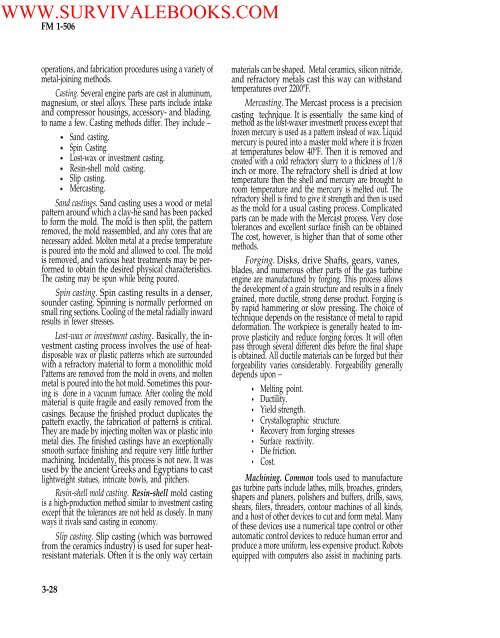FM 1-506 Fundamentals of Aircraft Power Plants ... - Survival Books
FM 1-506 Fundamentals of Aircraft Power Plants ... - Survival Books
FM 1-506 Fundamentals of Aircraft Power Plants ... - Survival Books
You also want an ePaper? Increase the reach of your titles
YUMPU automatically turns print PDFs into web optimized ePapers that Google loves.
WWW.SURVIVALEBOOKS.COM<strong>FM</strong> 1-<strong>506</strong>operations, and fabrication procedures using a variety <strong>of</strong>metal-joining methods.Casting. Several engine parts are cast in aluminum,magnesium, or steel alloys. These parts include intakeand compressor housings, accessory- and blading.to name a few. Casting methods differ. They include –Sand casting.Spin Casting.Lost-wax or investment casting.Resin-shell mold casting.Slip casting.Mercasting.Sand castings. Sand casting uses a wood or metalpattern around which a clay-he sand has been packedto form the mold. The mold is then split, the patternremoved, the mold reassembled, and any cores that arenecessary added. Molten metal at a precise temperatureis poured into the mold and allowed to cool. The moldis removed, and various heat treatments may be performedto obtain the desired physical characteristics.The casting may be spun while being poured.Spin casting. Spin casting results in a denser,sounder casting. Spinning is normally performed onsmall ring sections. Cooling <strong>of</strong> the metal radially inwardresults in fewer stresses.Lost-wax or investment casting. Basically, the investmentcasting process involves the use <strong>of</strong> heatdisposablewax or plastic patterns which are surroundedwith a refractory material to form a monolithic moldPatterns are removed from the mold in ovens, and moltenmetal is poured into the hot mold. Sometimes this pouringis done in a vacuum furnace. After cooling the moldmaterial is quite fragile and easily removed from thecasings. Because the finished product duplicates thepattern exactly, the fabrication <strong>of</strong> patterns is critical.They are made by injecting molten wax or plastic intometal dies. The finished castings have an exceptionallysmooth surface finishing and require very little furthermachining. Incidentally, this process is not new. It wasused by the ancient Greeks and Egyptians to castlightweight statues, intricate bowls, and pitchers.Resin-shell mold casting. Resin-shell mold castingis a high-production method similar to investment castingexcept that the tolerances are not held as closely. In manyways it rivals sand casting in economy.Slip casting. Slip casting (which was borrowedfrom the ceramics industry) is used for super heatresistantmaterials. Often it is the only way certainmaterials can be shaped. Metal ceramics, silicon nitride,and refractory metals cast this way can withstandtemperatures over 2200ºF.Mercasting. The Mercast process is a precisioncasting technique. It is essentially the same kind <strong>of</strong>method as the lost-waxer investment process except thatfrozen mercury is used as a pattern instead <strong>of</strong> wax. Liquidmercury is poured into a master mold where it is frozenat temperatures below 40ºF. Then it is removed andcreated with a cold refractory slurry to a thickness <strong>of</strong> 1/8inch or more. The refractory shell is dried at lowtemperature then the shell and mercury are brought toroom temperature and the mercury is melted out. Therefractory shell is fired to give it strength and then is usedas the mold for a usual casting process. Complicatedparts can be made with the Mercast process. Very closetolerances and excellent surface finish can be obtainedThe cost, however, is higher than that <strong>of</strong> some othermethods.Forging. Disks, drive Shafts, gears, vanes,blades, and numerous other parts <strong>of</strong> the gas turbineengine are manufactured by forging. This process allowsthe development <strong>of</strong> a grain structure and results in a finelygrained, more ductiIe, strong dense product. Forging isby rapid hammering or slow pressing. The choice <strong>of</strong>technique depends on the resistance <strong>of</strong> metal to rapiddeformation. The workpiece is generally heated to improveplasticity and reduce forging forces. It will <strong>of</strong>tenpass through several different dies before the final shapeis obtained. All ductile materials can be forged but theirforgeability varies considerably. Forgeability generallydepends upon –Melting point.Ductility.Yield strength.Crystallographic structure.Recovery from forging stressesSurface reactivity.Die friction.Cost.Machining. Common tools used to manufacturegas turbine parts include lathes, mills, broaches, grinders,shapers and planers, polishers and buffers, drills, saws,shears, filers, threaders, contour machines <strong>of</strong> all kinds,and a host <strong>of</strong> other devices to cut and form metal. Many<strong>of</strong> these devices use a numerical tape control or otherautomatic control devices to reduce human error andproduce a more uniform, less expensive product. Robotsequipped with computers also assist in machining parts.3-28
















